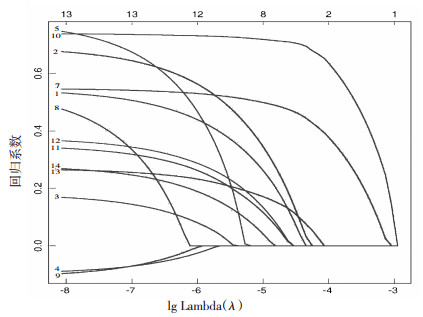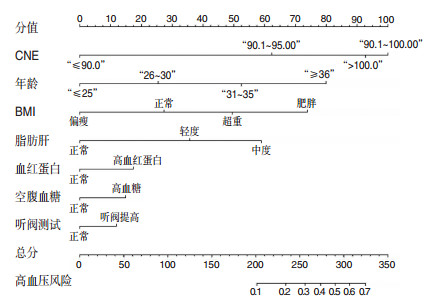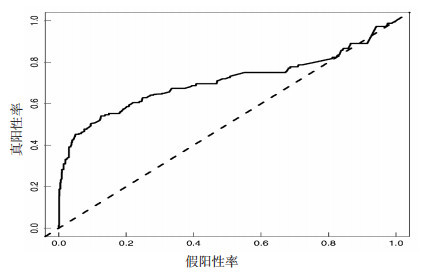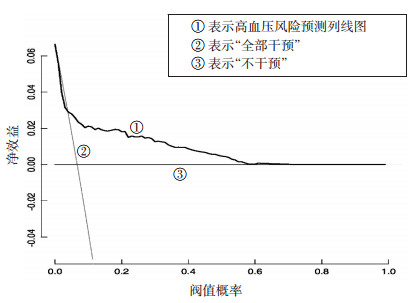Study on risk factors of hypertension among noise-exposed workers and prediction model
-
+ English摘要:目的
探讨噪声作业工人患高血压的影响因素,建立高血压风险模型及个体预测工具。
方法选取2017年2家汽车制造企业的4 951名男性噪声作业工人为研究对象,以职业健康检查及现场调查资料为基础,分析高血压患病情况。采用lasso-logistic回归分析法筛选作业工人患高血压的影响因素,建立列线图预测模型,并使用ROC曲线和决策曲线分析评价模型的实用性,应用自抽样法进行模型内部验证。
结果4 951名研究对象平均年龄(29.9±4.5)岁,高血压检出率为6.65%。lasso-logistic回归分析得出:累积噪声暴露量90.1~95.0 dB(A)·年组、95.1~100.0 dB(A)·年组及> 100.0 dB(A)·年组发生高血压风险分别是≤90.0 dB(A)·年组的4.666倍、11.810倍、9.785倍(P均 < 0.01);听阈提高组发生高血压的风险是正常组的1.348倍(P < 0.05);年龄31~35岁组、≥36岁组发生高血压的风险分别是≤25岁组的3.669倍、7.353倍(P均 < 0.01);高血红蛋白组发生高血压的风险是正常组的1.498倍(P < 0.01);对噪声作业工人高血压有影响的其他危险因素还包括超重或肥胖、脂肪肝、空腹高血糖(OR值为1.448~5.839,P < 0.05)。高血压风险预测列线图模型的ROC曲线下面积为0.705,经内部验证后,C指数为0.696。决策曲线分析表明,列线图模型在阈值概率超过0.03的情况下进行高血压的预防干预具有意义。
结论噪声作业工人有更高的患高血压的风险,年龄、BMI和其他个体因素对血压也有影响。基于lassologistic回归制作的高血压风险列线图预测模型具有一定的准确性和可操作性。
-
高血压是最常见的慢性心血管疾病,近年来患病率持续增高[1]。国内外相关研究[2]及本项目组前期研究[3-4]发现,噪声是作业人群患高血压的危险因素,且作业工人接触职业性噪声较为普遍,人群基数大。然而,不同的作业暴露环境以及不同的个体健康状态导致高血压患病机会有所不同,且目前对噪声作业人群高血压风险及个体预测预警的研究较少。因此,本研究拟选择噪声作业工人为研究对象,对其患高血压的危险因素进行分析,并建立高血压风险模型及个体预测工具,为噪声作业人群高血压的预防和早期干预提供理论依据和科学指导。
1. 对象与方法
1.1 对象
采用整群抽样法,将广州市2家汽车制造企业5 055名噪声作业工人作为研究对象,其中排除了女性工人45名(占0.89%)和资料不全者59人(占1.17%),最终纳入4 951名研究对象。纳入标准:依据《工作场所物理因素测量第8部分:噪声》(GBZ /T 189. 8-2007)[5],经检测其工作场所和岗位噪声8 h等效声级≥80 dB(A); 2017年完成在岗期间职业健康检查; 噪声作业工龄≥3.0年; 无高血压家族史和其他心血管疾病家族史; 无听觉系统疾病; 无颅脑损伤史、爆震史、家族性耳聋史、耳毒性药物服用史; 既往无肝肾疾病、心脏病等重大疾病病史等。本研究经广州市职业病防治院医学伦理委员会审查批准,所有研究对象均知情同意。
1.2 方法
1.2.1 职业健康检查和调查
噪声作业工人均严格按照《职业健康监护技术规范》(GBZ 188-2014)[6]进行职业健康检查,检查项目包括症状询问,体格检查,血压、血常规、心电图、肝胆脾B超、肝功能检查,以及纯音听阈测试等。同时调查噪声作业工人的职业史、职业暴露史、既往史、家族史和药物史等。
根据GBZ/T 189.8-2007,采用AWA 5610 P型噪声仪(杭州爱华科技有限公司)对工作场所噪声声级进行测量。为综合考虑噪声暴露声级和接噪时间,采用累积噪声暴露量(cumulative noise exposure,CNE)量化作业工人的噪声水平。研究对象在一个工作环境中的CNE采用如下公式计算:
$$ {\rm{CNE}} = {L_{{\rm{Aeq}}, 8{\rm{h}}}} + 10\lg t $$ 式中,CNE为累积噪声暴露量,单位:dB(A)·年; LAeq,8 h为8 h等效声级,单位:dB(A); t为接噪时间,单位:年。
检查指标结果的判定和分类。体质量指数(body mass index,BMI):测量研究对象的身高和体质量,BMI =体质量(kg)/[身高(m)] 2,其中BMI<18.5 kg/m2为偏瘦,18.5 ~ 23.9 kg/m2为正常,24.0 ~ 27.9 kg/m2为超重,≥ 28 kg/m2为肥胖。脉率:60 ~ 100 /min为正常,<60 /min或>100 /min为异常。心电图检查:异常结果主要包括心律不齐、心动过速或过缓、期前收缩、束支阻滞、波形改变等。超声波检查脂肪肝[7]:分为无、轻度、中度(研究对象无重度脂肪肝)。空腹血糖:3.9 ~ 6.1 mmol/L为正常,>6.1 mmol/L为高血糖(研究对象无<3.9 mmol/L)。血红蛋白:120 ~ 165 g/L为正常,>165 g/L为高血红蛋白(研究对象无<120 g/L)。肝功能:谷丙转氨酶(ALT)和谷草转氨酶(AST)活性在0 ~ 40 μ/L范围内为正常,ALT或AST>40 μ/L为活性提高。纯音气导听阈测试:检查结果分为听力正常和听阈提高[6, 8],听阈提高是指任一耳任一频段中,语频听阈(500、1 000、2 000 Hz)或高频听阈(3 000、4 000、6 000 Hz)大于25 dB。
1.2.2 血压测量
采用经过定期校准的HEM-746C型电子血压计(日本欧姆龙公司),在安静状态下测量研究对象坐位上臂血压。每人测量3次,取平均值作为血压测定的最终值,得出收缩压、舒张压,计算脉压、平均动脉压。高血压的诊断标准参照《中国高血压防治指南》(2010年修订版)[9]的相关定义:在未使用抗高血压药物的情况下,收缩压≥140 mmHg或(和)舒张压≥90 mmHg者; 既往有高血压病史,目前正在服用抗高血压药物,血压虽低于140/90 mmHg者,也应诊断为高血压。
1.2.3 统计学分析
采用Excel 2016进行数据的查重和逻辑纠错。年龄、CNE、血压值等计量资料,经正态性检验符合正态分布者,采用均数±标准差(x ± s)来表示,不符合正态分布的以中位数和第25、75百分位数[M(P25,P75)]表示。对各项影响因素进行分层整理,计数资料以百分率表示,使用SPSS 23.0统计学软件完成率的比较。使用R软件(版本3.5.0;https://www.r-project.org)建立风险预测模型并进行评价。其中,应用lasso回归模型筛选高血压患病风险的影响因素,使用交叉验证法计算lambda(λ)值,以误差最小的lambda(λ)值为标准,所对应的因素种类即为筛选出来的高血压风险影响因素。应用二分类logistic回归(输入法,自变量引入标准为0.05)对筛选出来的影响因素进行分析,检验水准α = 0.05(双侧); 根据回归系数绘制列线图。应用ROC曲线法和bootstrap自抽样法(1 000样本)评价模型的预测能力,应用决策分析方法评价模型的临床应用价值。
2. 结果
2.1 基本情况
对纳入研究的企业生产环境和职业病危害因素进行调查检测,可能存在的职业病危害因素主要有噪声(机械性噪声为主)、高温、粉尘(包括:电焊烟尘、金属粉尘、砂轮磨尘、有机粉尘等)、有机溶剂(包括:苯、甲苯、二甲苯、甲醇、甲醛、乙酸乙酯等)、无机化合物(二氧化锰、氮氧化物等)、手传振动等。工作场所噪声8 h等效声级[M(P25,P75)]为84.5(82.9,89.3) dB(A)。4 951名研究对象年龄为(29.9 ± 4.5)岁,平均接噪工龄为(8.9 ± 3.5)年。血压情况:高血压检出率为6.65%,平均收缩压为(123.6 ± 10.9) mmHg,平均舒张压为(77.5 ± 8.4)mmHg,平均脉压为(46.1 ± 9.1) mmHg,平均动脉压为(92.8 ± 8.3)mmHg; 平均脉率为(75.5 ± 5.8)/min。根据血压情况,将研究对象分为血压正常和高血压两组,并根据CNE、年龄、职业病危害因素暴露情况、职业健康检查结果等得出两组研究对象的高血压患病情况。经分析发现,CNE、年龄、体质量指数不同,以及心电图、脂肪肝、空腹血糖、血红蛋白、听阈测试、ALT或AST活性检测结果不同的工人间高血压患病率也不同(P < 0.05)。见表 1。
表 1 不同个体特征对象高血压患病情况[人数(占比/%)] 工人特征 血压正常(n = 4 622) 高血压(n = 329) χ2值 P值 CNE/[dB(A)·年] 8.927 <0.05 ≤90.0 327(96.5) 12(3.5) 90.1 ~ 95.0 2 332(93.7) 156(6.3) 95.1 ~ 100.0 1 699(92.5) 138(7.5) >100.0 264(92.0) 23(8.0) 年龄/岁 32.592 <0.01 ≤25 260(97.7) 6(2.3) 26 ~ 30 2 236(94.6) 127(5.4) 31 ~ 35 1 536(92.4) 127(7.6) ≥36 590(89.5) 69(10.5) 苯系物暴露 1.995 <0.05 无 3 953(93.6) 272(6.4) 有 669(92.1) 57(7.9) 粉尘暴露 0.603 >0.05 无 2 328(93.1) 173(6.9) 有 2 294(93.6) 156(6.4) 高温暴露 0.957 >0.05 无 4 594(93.4) 325(6.6) 有 28(87.5) 4(12.5) 接触危害因素种类数 1.123 >0.05 2种 1 849(93.7) 125(6.3) 3种 2 555(93.0) 191(7.0) 4种 218(94.4) 13(5.6) BMI 212.306 <0.01 偏瘦 412(98.3) 7(1.7) 正常 3 007(95.9) 128(4.1) 超重 1 009(88.2) 135(11.8) 肥胖 194(76.7) 59(23.3) 脉率 0.000 >0.05 正常 4 581(93.4) 326(6.6) 异常 41(93.2) 3(6.8) 心电图 5.821 <0.05 正常 3 191(92.8) 248(7.2) 异常 1 431(94.6) 81(5.4) 脂肪肝 223.664 <0.01 正常 3 290(96.6) 115(3.4) 轻度 1 269(87.1) 188(12.9) 中度 63(70.8) 26(29.2) 空腹血糖 28.176 <0.01 正常 4 053(94.1) 255(5.9) 高血糖 569(88.5) 74(11.5) 血红蛋白 14.854 <0.01 正常 3 818(94.0) 244(6.0) 高血红蛋白 804(90.4) 85(9.6) ALT或AST活性 92.937 <0.01 正常 3 968(94.8) 217(5.2) 活性提高 654(85.4) 112(14.6) 听阈测试 7.342 <0.01 正常 3 394(93.9) 219(6.1) 听阈提高 1 228(91.8) 110(8.2) 2.2 噪声作业工人患高血压的影响因素分析
采用lasso回归分析选择高血压影响因素。纳入的影响因素包括:CNE、年龄、苯系物暴露、粉尘暴露、高温暴露、接触危害因素种类数、BMI、脉率、心电图、脂肪肝、空腹血糖、血红蛋白、ALT或AST活性、听阈测试等14个因素。通过交叉验证法计算lambda(λ)值,得出如图 1中的两条虚线之间的值域为lambda(λ)值正负标准差的范围,在此范围内模型预测偏差变动的幅度会相对较小。选择误差最小时的lambda(λ)值(左边虚线)所对应的影响因素数目为13个(图 1、图 2上方数值表示影响因素个数)。图 2表示剔除了系数为0的因素6“接触危害因素种类数”后,各影响因素的系数绝对值随着lambda(λ)值的变大而压缩。根据图 1和图 2,保留的影响因素包括:CNE、年龄、苯系物暴露、粉尘暴露、高温暴露、BMI、脉率、心电图、脂肪肝、空腹血糖、血红蛋白、ALT或AST活性、听阈测试结果。
2.3 高血压个体风险预测模型的建立与应用
将上述筛选得到的13个影响因素作为自变量,以噪声作业工人是否有高血压作为因变量,进行logistic回归分析。结果显示:按CNE分组,90.1 ~ 95.0 dB(A)·年组发生高血压的风险是≤ 90.0 dB(A)·年组的4.666倍(P<0.01),95.1 ~ 100.0 dB(A)·年组发生高血压的风险是≤ 90.0 dB(A)·年组的11.810倍(P<0.01),>100.0 dB(A)·年组发生高血的压风险是≤ 90.0 dB(A)·年组的9.785倍(P<0.01);按年龄分组,31 ~ 35岁组发生高血压的风险是≤ 25岁组的3.669倍(P<0.01),≥ 36岁组发生高血压的风险是≤ 25岁组的7.353倍(P<0.01);按BMI分组,超重组发生高血压的风险是偏瘦组的3.226倍(P<0.01),肥胖组发生高血压的风险是偏瘦组的5.839倍(P<0.001);按脂肪肝严重程度分组,轻度组发生高血压的风险是正常组的2.260倍(P<0.01),中度组发生高血压的风险是正常组的3.660倍(P<0.001);高空腹血糖组发生高血压的风险是正常组的1.448倍(P<0.05);高血红蛋白组发生高血压的风险是正常组的1.498倍(P<0.01);听阈提高组发生高血压的风险是听阈正常组的1.348倍(P<0.05)。见表 2。
表 2 噪声作业工人患高血压影响因素的多因素分析影响因素 回归系数 标准误 Wald χ2值 P值 OR(95%CI)值 截距 - 7.115 0.662 -10.750 <0.01 0.001(0.000 ~ 0.003) CNE/[dB(A)·年] 90.1 ~ 95.0 1.540 0.341 4.523 <0.01 4.666(2.472 ~ 9.493) 95.1 ~ 100.0 2.469 0.359 6.874 <0.01 11.810(6.019 ~ 24.831) >100.0 2.281 0.414 5.506 <0.01 9.785(4.413 ~ 22.609) 年龄/岁 26 ~ 30 0.639 0.432 1.480 >0.05 1.894(0.883 ~ 4.935) 31 ~ 35 1.300 0.447 2.909 <0.01 3.669(1.651 ~ 9.793) ≥ 36 1.995 0.459 4.346 <0.01 7.353(3.212 ~ 19.997) 苯系物暴露 0.177 0.166 1.071 >0.05 1.194(0.856 ~ 1.640) 粉尘暴露 - 0.120 0.124 -0.970 >0.05 0.887(0.696 ~ 1.130) 高温暴露 0.818 0.576 1.420 >0.05 2.266(0.629 ~ 6.331) BMI 正常 0.653 0.396 1.650 >0.05 1.921(0.951 ~ 4.591) 超重 1.171 0.411 2.848 <0.01 3.226(1.539 ~ 7.903) 肥胖 1.765 0.437 4.035 <0.01 5.839(2.621 ~ 14.905) 脉率 0.575 0.629 0.913 >0.05 1.776(0.411 ~ 5.258) 心电图 - 0.114 0.140 - 0.808 >0.05 0.893(0.675 ~ 1.171) 脂肪肝 轻度 0.815 0.157 5.203 <0.01 2.260(1.662 ~ 3.073) 中度 1.298 0.305 4.249 <0.01 3.660(1.990 ~ 6.604) 空腹血糖 0.370 0.154 2.407 <0.05 1.448(1.065 ~ 1.947) 血红蛋白 0.404 0.143 2.836 <0.01 1.498(1.128 ~ 1.973) ALT或AST活性 0.254 0.148 1.717 >0.05 1.289(0.962 ~ 1.720) 听阈测试 0.299 0.130 2.301 <0.05 1.348(1.043 ~ 1.735) [注]因变量赋值:0 =非高血压,1 =高血压。自变量赋值中,CNE:0 = ≤ 90.0 dB(A)·年,1 = 90.1 ~ 95.0 dB(A)·年,2 = 95.1 ~ 100.0 dB(A)·年,3 =>100.0 dB(A)·年; 年龄:0 = ≤ 25岁,1 = 26 ~ 30岁,2 = 31 ~ 35岁,3 = ≥ 36岁; 苯系物暴露:0 =无,1 =有; 粉尘暴露:0 =无,1 =有; 高温暴露:0 =无,1 =有; 体质量指数:0 =偏瘦,1 =正常,2 =超重,3 =肥胖; 脉率:0 =正常,1 =异常; 心电图:0 =正常,1 =异常; 脂肪肝:0 =无,1 =轻度,2 =中度; 空腹血糖:0 =正常,1 =异常; 血红蛋白:0 =正常,1 =异常; ALT或AST活性:0 =正常,1 =提高; 听阈测试:0 =听力正常,1 =听阈提高。均以赋值最小者为对照组 根据此7个影响因素的回归系数制作的列线图见图 3。调查计算作业工人的CNE、年龄、BMI、脂肪肝、空腹血糖、血红蛋白、听阈测试结果,然后按照列线图中各自相应的得分计算出总分后所垂直对应的概率则为该作业工人患高血压的概率。如调查检查某噪声作业工人年龄为34岁、CNE为97.5 dB(A)·年、BMI为超重、有轻度脂肪肝、听阈测试提高、血红蛋白无增高、空腹血糖无增高,则各因素对应分值分别为52.5分、100分、50分、35分、12.5分、0分、0分,合计为250分。此分数垂直对应高血压风险值约为0.27,即该作业工人患高血压的概率为27%。
2.4 风险预测模型评价与验证
制作高血压风险预测列线图ROC工作特征曲线,见图 4。曲线下面积为0.705(长方形总面积为1),说明列线图预测效果较好。采用bootstrap自抽样法评价此列线图模型,C指数为0.696,表明列线图模型具有较好的预测能力。
图 5为决策分析曲线。阈值概率对于高血压风险的干预具有重要的意义。由图可知,当阈值概率超过0.03时,使用此列线图模型预测患高血压风险比“全部干预”或“不干预”策略提供了更高的净效益,也说明此列线图模型对于作业工人高血压的预防具有积极的意义。
3. 讨论
高血压的形成是多种危害因素共同影响的结果,如遗传、年龄、性别、BMI、不同生理状态等。而处于一线的作业工人,由于长期接触职业病危害因素,特别是长期接触职业性噪声、高温等,可导致血压持续升高[10]。因此,筛选出噪声作业工人患高血压的影响因素,并建立高血压个体预测模型,对这些作业工人高血压的早期预警以及建立有针对性的干预措施有积极的作用[11]。
3.1 高血压影响因素的筛选与分析
本研究采用lasso回归作为变量选择模型,该模型本质上是一种带惩罚约束的最小二乘法。通过将不显著系数缩减为0的方式,保留少数显著的变量,极大地削弱多重共线性的影响。与传统的变量选择方法相比,lasso回归很好地克服了传统方法在选择变量上的不足,具有预测能力强、稳健性高的优势[12]。本研究通过lasso-logistic回归分析后,筛选得出噪声作业工人患高血压的影响因素共7种,包括CNE、年龄、BMI、脂肪肝、空腹血糖、血红蛋白、听阈测试结果。
累积噪声暴露量(CNE)综合考虑了接触噪声的声级和工龄。本研究通过CNE作为衡量噪声暴露的评价指标,发现作业工人高血压的患病率随CNE的增加呈剂量-效应关系(P<0.01),与李嘉辉等[4]的研究一致。原因可能是:(1)噪声的接触量越大,越容易使机体内分泌失调,血压上升; (2)机体接触噪声刺激,导致抗氧化防御系统受损,体内产生大量活性氧(reactive oxygen species,ROS),使机体处于氧化应激的状态,引起了血压持续升高和血管损害。故建议要加强噪声防护措施的设置,降低接触噪声声级,对工龄长的噪声作业工人进行调岗、轮岗,以减少工人患高血压的风险。
年龄增加是噪声作业工人高血压患病率升高的主要因素之一(P<0.05),与钱庆增等[13]、陈美池[14]的研究一致。随着年龄的增大,心血管系统功能开始减弱,血管逐渐硬化,弹性减退,从而导致血压升高。
本研究采用BMI来评估对象的肥胖程度,结果显示随BMI和脂肪肝严重程度的增加,工人患高血压的风险呈上升趋势(P<0.01)。这可能是体内脂代谢紊乱和脂肪堆积能导致血液的黏稠度增加,影响血压[15]。另有报道表明,接触噪声促使作业工人血脂异常,因此高血压更容易发生[16]。
本研究还发现血红蛋白和血糖水平与患高血压风险相关(P<0.05)。这可能由于血红蛋白水平的升高,致使血液黏度增加[17]、血管内膜增生[18],进而促使血压水平增加。另外,血糖的升高可能会刺激胰岛分泌胰岛素,激活丝裂原活化蛋白激酶(mitogen-activated protein kinases,MAPK)通路,促使释放内皮缩血管肽,使血压升高[19]。
经多因素logistic回归分析调整混杂因素后,发现听阈提高的作业工人患高血压的风险高于听力正常者(P<0.05),与多篇报道的研究结果[20-23]一致。研究提示了职业性噪声导致的听阈提高或听力损失可能是患高血压的独立危险因素,这可能是由于噪声引起的听阈提高形成了反馈调节,导致人体内分泌失调,表现为交感神经兴奋,心率和脉搏加快,心输出量增加,致使血压上升。同时也间接印证了职业病危害因素噪声对作业工人罹患高血压的影响。
然而,本研究没有发现其他职业病危害因素,如粉尘、苯系物和(或)高温会提高作业工人患高血压的风险(P>0.05)。有多项研究显示,多种职业病危害因素联合作用时,患高血压的风险会增加[24-25],但本研究结果未能体现。这可能由于未细致考虑各职业病危害因素的接触强度和时间,以及调查样本量不足所致。高血压的影响因素非常复杂,本研究纳入的影响因素尚缺少工人的防护用品佩戴情况、生活饮食习惯、行为方式和遗传因素等的影响,可能在一定程度上影响了高血压影响因素分析的全面性。
3.2 高血压的预测与预防
本研究中采用lasso-logistic回归所形成的预测模型具有较好的预测效能,得到的列线图模型可作为接触噪声企业或个人预测高血压的简易工具,同时也能够提示企业或个人对危险因素进行定期监测和早期干预[11]。我们可在此模型工具的基础上,建立有针对性的防护措施,这对于保护作业工人的职业健康,提高企业的效益具有一定的积极意义。本次研究的结果也提示:存在噪声岗位的企业要重视噪声防控措施的落实,加强作业工人的个人防护; 着重对超重及肥胖的噪声作业工人予以营养干预和健康教育促进,倡导低脂低盐膳食、适当体育训练等; 企业要落实职业健康体检制度,更多关注作业工人的生理状况。不过,尽管此列线图模型具有较好的预测性能,并得到内部验证,但此模型仅针对一个行业、两个企业的工人的数据得出,因此是否具有适用于其他厂区和岗位预测的普遍性尚不确定。
-
表 1 不同个体特征对象高血压患病情况
[人数(占比/%)] 工人特征 血压正常(n = 4 622) 高血压(n = 329) χ2值 P值 CNE/[dB(A)·年] 8.927 <0.05 ≤90.0 327(96.5) 12(3.5) 90.1 ~ 95.0 2 332(93.7) 156(6.3) 95.1 ~ 100.0 1 699(92.5) 138(7.5) >100.0 264(92.0) 23(8.0) 年龄/岁 32.592 <0.01 ≤25 260(97.7) 6(2.3) 26 ~ 30 2 236(94.6) 127(5.4) 31 ~ 35 1 536(92.4) 127(7.6) ≥36 590(89.5) 69(10.5) 苯系物暴露 1.995 <0.05 无 3 953(93.6) 272(6.4) 有 669(92.1) 57(7.9) 粉尘暴露 0.603 >0.05 无 2 328(93.1) 173(6.9) 有 2 294(93.6) 156(6.4) 高温暴露 0.957 >0.05 无 4 594(93.4) 325(6.6) 有 28(87.5) 4(12.5) 接触危害因素种类数 1.123 >0.05 2种 1 849(93.7) 125(6.3) 3种 2 555(93.0) 191(7.0) 4种 218(94.4) 13(5.6) BMI 212.306 <0.01 偏瘦 412(98.3) 7(1.7) 正常 3 007(95.9) 128(4.1) 超重 1 009(88.2) 135(11.8) 肥胖 194(76.7) 59(23.3) 脉率 0.000 >0.05 正常 4 581(93.4) 326(6.6) 异常 41(93.2) 3(6.8) 心电图 5.821 <0.05 正常 3 191(92.8) 248(7.2) 异常 1 431(94.6) 81(5.4) 脂肪肝 223.664 <0.01 正常 3 290(96.6) 115(3.4) 轻度 1 269(87.1) 188(12.9) 中度 63(70.8) 26(29.2) 空腹血糖 28.176 <0.01 正常 4 053(94.1) 255(5.9) 高血糖 569(88.5) 74(11.5) 血红蛋白 14.854 <0.01 正常 3 818(94.0) 244(6.0) 高血红蛋白 804(90.4) 85(9.6) ALT或AST活性 92.937 <0.01 正常 3 968(94.8) 217(5.2) 活性提高 654(85.4) 112(14.6) 听阈测试 7.342 <0.01 正常 3 394(93.9) 219(6.1) 听阈提高 1 228(91.8) 110(8.2) 表 2 噪声作业工人患高血压影响因素的多因素分析
影响因素 回归系数 标准误 Wald χ2值 P值 OR(95%CI)值 截距 - 7.115 0.662 -10.750 <0.01 0.001(0.000 ~ 0.003) CNE/[dB(A)·年] 90.1 ~ 95.0 1.540 0.341 4.523 <0.01 4.666(2.472 ~ 9.493) 95.1 ~ 100.0 2.469 0.359 6.874 <0.01 11.810(6.019 ~ 24.831) >100.0 2.281 0.414 5.506 <0.01 9.785(4.413 ~ 22.609) 年龄/岁 26 ~ 30 0.639 0.432 1.480 >0.05 1.894(0.883 ~ 4.935) 31 ~ 35 1.300 0.447 2.909 <0.01 3.669(1.651 ~ 9.793) ≥ 36 1.995 0.459 4.346 <0.01 7.353(3.212 ~ 19.997) 苯系物暴露 0.177 0.166 1.071 >0.05 1.194(0.856 ~ 1.640) 粉尘暴露 - 0.120 0.124 -0.970 >0.05 0.887(0.696 ~ 1.130) 高温暴露 0.818 0.576 1.420 >0.05 2.266(0.629 ~ 6.331) BMI 正常 0.653 0.396 1.650 >0.05 1.921(0.951 ~ 4.591) 超重 1.171 0.411 2.848 <0.01 3.226(1.539 ~ 7.903) 肥胖 1.765 0.437 4.035 <0.01 5.839(2.621 ~ 14.905) 脉率 0.575 0.629 0.913 >0.05 1.776(0.411 ~ 5.258) 心电图 - 0.114 0.140 - 0.808 >0.05 0.893(0.675 ~ 1.171) 脂肪肝 轻度 0.815 0.157 5.203 <0.01 2.260(1.662 ~ 3.073) 中度 1.298 0.305 4.249 <0.01 3.660(1.990 ~ 6.604) 空腹血糖 0.370 0.154 2.407 <0.05 1.448(1.065 ~ 1.947) 血红蛋白 0.404 0.143 2.836 <0.01 1.498(1.128 ~ 1.973) ALT或AST活性 0.254 0.148 1.717 >0.05 1.289(0.962 ~ 1.720) 听阈测试 0.299 0.130 2.301 <0.05 1.348(1.043 ~ 1.735) [注]因变量赋值:0 =非高血压,1 =高血压。自变量赋值中,CNE:0 = ≤ 90.0 dB(A)·年,1 = 90.1 ~ 95.0 dB(A)·年,2 = 95.1 ~ 100.0 dB(A)·年,3 =>100.0 dB(A)·年; 年龄:0 = ≤ 25岁,1 = 26 ~ 30岁,2 = 31 ~ 35岁,3 = ≥ 36岁; 苯系物暴露:0 =无,1 =有; 粉尘暴露:0 =无,1 =有; 高温暴露:0 =无,1 =有; 体质量指数:0 =偏瘦,1 =正常,2 =超重,3 =肥胖; 脉率:0 =正常,1 =异常; 心电图:0 =正常,1 =异常; 脂肪肝:0 =无,1 =轻度,2 =中度; 空腹血糖:0 =正常,1 =异常; 血红蛋白:0 =正常,1 =异常; ALT或AST活性:0 =正常,1 =提高; 听阈测试:0 =听力正常,1 =听阈提高。均以赋值最小者为对照组 -
[1] 申洋, 王馨, 王增武, 等.我国职业场所高血压综合干预效果评价[J].中华流行病学杂志, 2019, 40(2):212-217. doi: 10.3760/cma.j.issn.0254-6450.2019.02.017 [2] 梁肖, 程培培, 闫英洁, 等.我国钢铁厂噪声与高血压发病风险关系的Meta分析[J].中华疾病控制杂志, 2017, 21(8):841-845. http://d.old.wanfangdata.com.cn/Periodical/jbkzzz201708021 [3] 陶志民, 李嘉辉, 黄丽丽, 等.噪声作业工人听力损失与高血压、心电图异常关系[J].中国职业医学, 2017, 44(2):176-180, 187. http://d.old.wanfangdata.com.cn/Periodical/zgzyyx201702012 [4] 李嘉辉, 陶志民, 黄丽丽, 等.汽车制造业工人累积噪声暴露量对高血压影响[J].中国职业医学, 2018, 45(2):47-51. http://d.old.wanfangdata.com.cn/Periodical/zgzyyx201802011 [5] 中华人民共和国国家卫生和计划生育委员会.工作场所物理因素测量第8部分: 噪声: GBZ/T 189. 8-2007[S].北京: 中国标准出版社, 2007. [6] 中华人民共和国国家卫生和计划生育委员会.职业健康监护技术规范: GBZ 188-2014[S].北京: 中国标准出版社, 2014. [7] 洪传美. B超在脂肪肝诊断中的应用研究[J].现代实用医学, 2010, 22(2):204-205. doi: 10.3969/j.issn.1671-0800.2010.02.041 [8] 中华人民共和国国家卫生和计划生育委员会.职业性噪声聋的诊断: GBZ 49-2014[S].北京: 中国标准出版社, 2014. [9] 刘力生.中国高血压防治指南2010[J].中华高血压杂志, 2011, 19(8):701-743. http://d.old.wanfangdata.com.cn/Periodical/zhxxgb201107002 [10] 王致, 陶志民, 周浩, 等.广州市汽车整车制造企业噪声作业工人职业健康状况分析[J].中国卫生工程学, 2016, 15(3):209-211, 214. http://www.wanfangdata.com.cn/details/detail.do?_type=perio&id=zgwsgcx201603004 [11] 钱庆增, 曹向可, 曲艺, 等.早期预警干预对钢铁企业高温、噪声作业者血压的影响[J].职业与健康, 2017, 33(21):40-43, 48. http://d.old.wanfangdata.com.cn/Periodical/zyyjk201721009 [12] 郭貔, 王力, 郝元涛.基于lasso回归模型与百度搜索数据构建的流感疫情预测系统[J].中国卫生统计, 2017, 34(2):186-191. http://d.old.wanfangdata.com.cn/Periodical/zgwstj201702001 [13] 钱庆增, 曹向可, 李秀荣, 等.高温、噪声作业人员高血压患病情况及相关因素分析[J].重庆医学, 2018, 47(2):229-231, 235. doi: 10.3969/j.issn.1671-8348.2018.02.028 [14] 陈美池.噪声作业工人听力损失和心率改变与高血压患病的相关性[J].职业与健康, 2018, 34(6):737-741. http://d.old.wanfangdata.com.cn/Periodical/zyyjk201806005 [15] 沈莉英, 熊彩萍.老年高血压病患者血压与血脂、血糖及脂肪肝的关系[J].中国医药导刊, 2017, 19(6):625-626. doi: 10.3969/j.issn.1009-0959.2017.06.045 [16] 晏程, 袁惟芯, 谢春姣, 等.混苯及噪声暴露对工人脂肪肝患病率影响[J].中国公共卫生, 2015, 31(4):484-487. http://d.old.wanfangdata.com.cn/Periodical/zgggws201504032 [17] 丁飞, 王梅, 赵进容, 等.血红蛋白、血细胞比容与老年高血压患者舒张压的相关性[J].中国老年学杂志, 2017, 37(3):581-583. doi: 10.3969/j.issn.1005-9202.2017.03.024 [18] 李偲偲, 胡元会, 魏艺, 等.老年高血压病人舒张压与血红蛋白、红细胞比容的相关性分析[J].中西医结合心脑血管病杂志, 2016, 14(9):936-939. doi: 10.3969/j.issn.1672-1349.2016.09.003 [19] 赵立娜, 戴超, 成丽娟, 等.噪声暴露对某国有大型煤矿工人血糖和血脂水平的影响[J].实用预防医学, 2018, 25(8):12-14. http://d.old.wanfangdata.com.cn/Periodical/syyfyx201808002 [20] CHEN S, NI Y, ZHANG L, et al. Noise exposure in occupational setting associated with elevated blood pressure in China[J]. BMC Public Health, 2017, 17(1):1-7.
[21] 王晔, 刘献成, 王伟, 等.船员职业性噪声暴露与高血压的相关性[J].职业与健康, 2016, 32(14):1885-1887. http://d.old.wanfangdata.com.cn/Periodical/zyyjk201614004 [22] 郑瑶, 佟俊旺, 杨静波, 等.噪声所致工人听力损失与高血压的关系[J].中国工业医学杂志, 2015, 28(2):88-91, 94. http://www.wanfangdata.com.cn/details/detail.do?_type=perio&id=zggyyxzz201502002 [23] DE SOUZA T C F, PÉRISSÉ, SANTOS A R, MOURA M. Noise exposure and hypertension:investigation of a silent relationship[J]. BMC Public Health, 2015, 15(1):328.
[24] 杨娉婷, 陈志恒, 李莹, 等.常见职业因素与高血压的关系[J].中华高血压杂志, 2014, 22(6):533-535. http://d.old.wanfangdata.com.cn/Conference/9581373 [25] 高雪娟, 范红敏, 丛龙学, 等.接触噪声、高温和倒班与男性钢铁工人正常高值血压发生和高血压患病的关系[J].环境与职业医学, 2017, 34(9):765-771. http://d.old.wanfangdata.com.cn/Periodical/ldyx201709002 -
期刊类型引用(11)
1. 刘子秀,吕蒙,高丽,王姝文,兰跃燕,吴晓梅,朱博. 石化企业职业人群高血压危险因素分析及其患病风险预测. 工业卫生与职业病. 2023(02): 130-134 .  百度学术
百度学术
2. 施安琪,蒋丽,杨惠,沙磊. 2015—2021年南通市制造业工人噪声暴露及对血压的影响. 江苏预防医学. 2023(01): 95-96+101 .  百度学术
百度学术
3. 吴康勇,阮燕梅,王致. 噪声暴露与高血压发病风险的剂量-反应关系Meta分析. 中国工业医学杂志. 2023(04): 366-370+385 .  百度学术
百度学术
4. 谢庆堂,杨光,陈开,罗健,雷少颖. 职业性噪声作业工人双耳高频平均听阈与血压的关系. 工业卫生与职业病. 2021(05): 386-390+394 .  百度学术
百度学术
5. 郭笑笑,刘静,曾强. 职业性噪声暴露对劳动者高血压影响的研究进展. 职业与健康. 2021(20): 2869-2872 .  百度学术
百度学术
6. 邓颖聪,廖阳,凌伟洁,马炜钰,杜伟佳,王致,刘移民. 广州市不同规模工业企业职业病危害因素监测情况分析. 职业卫生与应急救援. 2021(06): 673-676+689 .  本站查看
本站查看
7. 荣幸,郭静宜,王致. 2018年广州市重点监测职业病危害因素作业劳动者职业健康检查结果分析. 中华劳动卫生职业病杂志. 2020(01): 37-41 .  百度学术
百度学术
8. 吴耀英. 临床护理路径对提高噪声作业人员护理服务质量的对策. 中国医药指南. 2020(22): 161-162 .  百度学术
百度学术
9. 管洪银,田鹏,陈燕,央拉,高飞飞,扎西罗布,阿旺多吉,德吉. 高原世居藏族高血压的独立危险因素分析. 中国当代医药. 2020(13): 166-169 .  百度学术
百度学术
10. 丘丛玺,张晋蔚,林秋月,周浩,肖吕武,李燕茹,刘移民. 广州汽车制造企业噪声作业工人健康状况调查. 职业卫生与应急救援. 2020(05): 497-500 .  本站查看
本站查看
11. 陈思枝,曹丹燕,李骏晖,黄丽蓉,吴小苑. 接触噪声与粉尘对工人血压的影响. 职业卫生与应急救援. 2019(05): 441-445 .  本站查看
本站查看
其他类型引用(6)





 下载:
下载:





